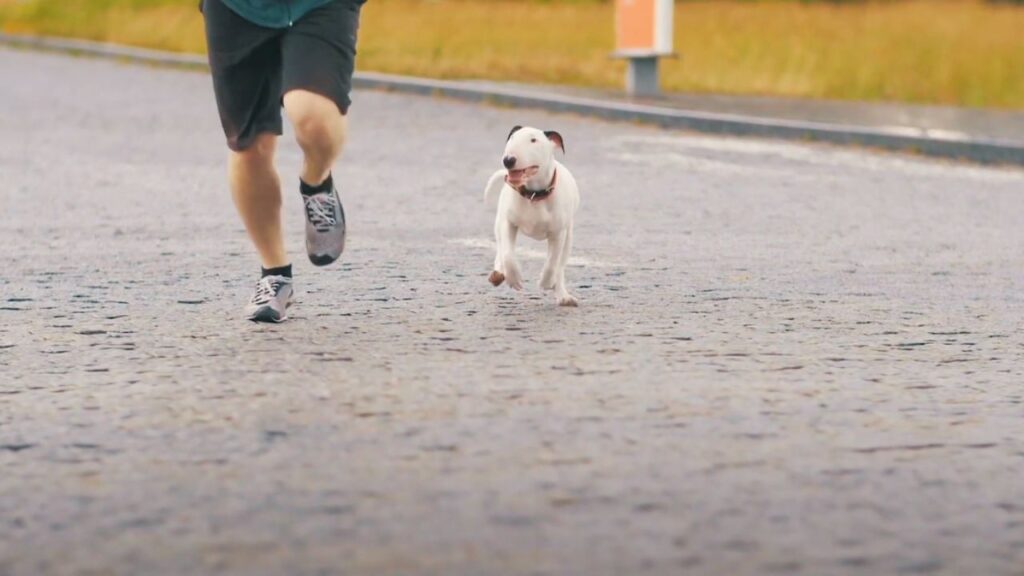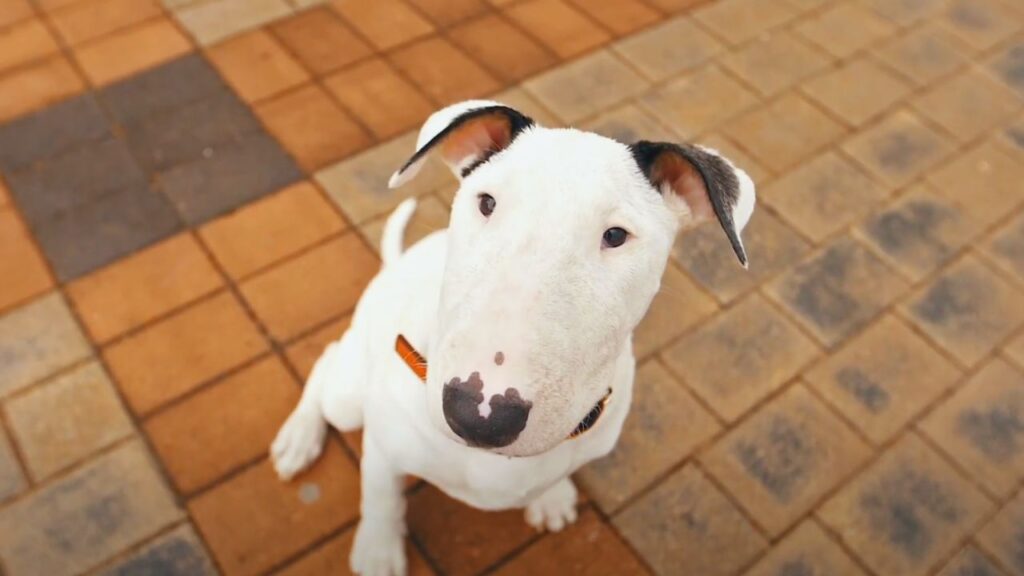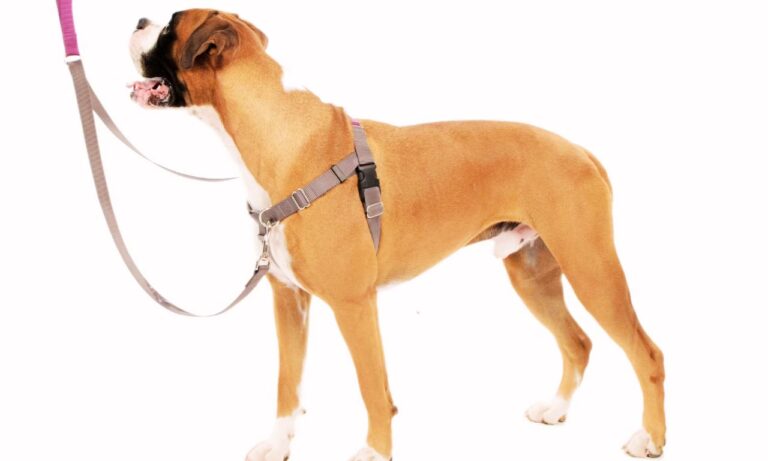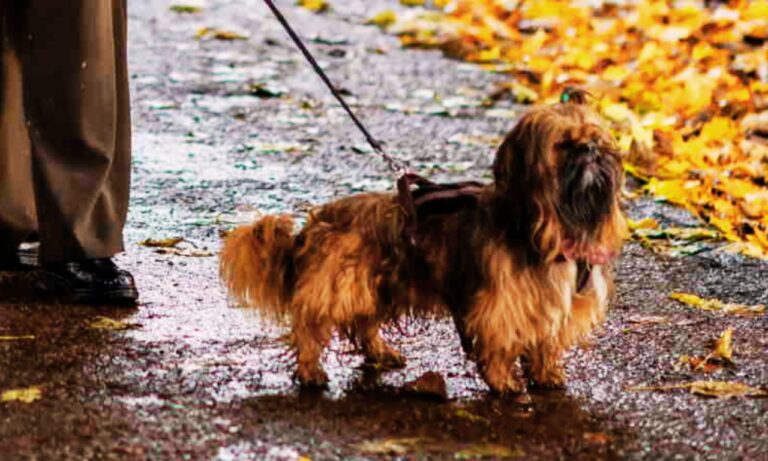Bull Terriers are known for their muscular build, strong personalities, and high energy levels, which can make walking them a challenge, especially if they have a tendency to pull on the leash. Leash pulling is not only frustrating but can also pose a safety risk for both you and your dog. So, how to stop your bull terrier pulling on walks?

Fortunately, with the right techniques, tools, and training, you can stop your Bull Terrier from pulling and enjoy peaceful, controlled walks. This guide will walk you through effective methods to address leash pulling, focusing on positive reinforcement, the use of specialized tools, and behavioral strategies. For a detailed guide on how to train a Bull Terrier with the right collar, check out this comprehensive article that outlines effective steps and techniques.
Blog Highlights
ToggleWhy Your Bull Terrier Pulls on the Leash?
Leash pulling is a common issue with Bull Terriers, often due to their natural exuberance and strength. These dogs are energetic and curious, making them eager to explore during walks. Pulling typically occurs because they want to reach something faster, whether it’s a smell, another dog, or an exciting object. It can also be a sign of frustration or lack of exercise.

The Importance of Early Training
It’s essential to start leash training early, ideally when your Bull Terrier is still a puppy. Puppies are more receptive to learning good habits, and instilling proper leash behavior at a young age can prevent future issues. However, if your dog is already an adult, don’t worry—Bull Terriers can still learn new behaviors with consistent training.
Here’s a quick-fix guide for stopping leash pulling:
Tools That Can Help
While training is essential, sometimes the right tools can assist in the process. Here are a few recommended options:
- Front-clip harness: Helps steer your dog back towards you when they pull.
- Head halter: Offers control over where your dog’s head (and thus body) is going.
- Standard leash (4-6 feet): A leash of this length provides enough control without giving your dog too much freedom to pull.
How to Stop Your Bull Terrier Pulling on Walks | Steps to Stop Leash Pulling
Walking a Bull Terrier that pulls on the leash can be challenging. However, with the right training, equipment, and consistency, you can teach your dog to walk calmly and enjoy peaceful outings together. Here’s, how to stop your bull terrier pulling on walks:

1. Use the Right Equipment
The right equipment can make a significant difference in controlling leash pulling. Consider using a front-clip harness, which is designed to turn your dog’s body back towards you when they pull, making it harder for them to yank forward.
A front-clip harness gives you better control and prevents strain on your dog’s neck. Many Bull Terrier owners find this tool highly effective because it allows for greater steering control. Learn the best practices for putting a collar on thick-skinned dogs to ensure a comfortable and irritation-free fit.
Another option is a head halter, which operates similarly to a halter on a horse. It helps guide your dog’s head, which in turn controls the body. This is especially useful for larger or stronger Bull Terriers. However, some dogs may need time to adjust to wearing a head halter, so patience is key.
2. Positive Reinforcement
One of the most effective ways to stop leash pulling is through positive reinforcement. Rewarding your Bull Terrier when they walk calmly beside you encourages them to continue the behavior.
The reward could be treats, praise, or even a favorite toy. The key is to reinforce the behavior you want rather than punishing the pulling behavior.
Start by giving your dog a treat when they walk beside you with a loose leash. Gradually extend the time between rewards as they improve. Over time, your Bull Terrier will associate walking calmly with getting rewarded.
3. Stop Moving When They Pull
Another simple but powerful technique is to stop moving whenever your Bull Terrier pulls on the leash. When your dog tugs, stand still and wait until they calm down and the leash becomes loose.
Once they’ve stopped pulling, you can continue walking. This method teaches your dog that pulling will not get them where they want to go, and only walking calmly will allow the walk to proceed.
4. Change Directions Frequently
To help your Bull Terrier focus on you during walks, you can try changing directions frequently. This unpredictable movement keeps them engaged and attentive, as they will need to watch where you are going. This method, often called “crazy walking,” is an excellent way to shift your dog’s attention back to you and away from distractions. Determine the ideal collar size for a Bernese Mountain Dog with this guide.
5. Teach “Heel” and Other Commands
Training your Bull Terrier to follow basic commands like “heel,” “sit,” or “stay” is a fundamental part of leash training. Teaching your dog to walk in the heel position—right beside you—can prevent pulling.
Use treats or toys to lure your dog into the correct position, and give the “heel” command as they follow. Practice this command both indoors and outdoors, gradually increasing the level of distractions.
6. Exercise Before Walks
Many Bull Terriers pull on the leash because they have pent-up energy. Ensuring your dog gets plenty of exercise before the walk can help reduce pulling. A tired dog is less likely to pull, so playing fetch, running, or engaging in other high-energy activities before a walk can make a big difference.
What Not to Do:
It’s crucial to avoid punitive methods like jerking the leash, using choke chains, or other forms of correction that can cause physical harm to your Bull Terrier. Not only can these methods hurt your dog, but they can also make the pulling worse by increasing anxiety or fear. Positive, reward-based training is far more effective and creates a better relationship between you and your dog.
Ensure that whatever tool you use is fitted properly to avoid discomfort or escape. Your Bull Terrier should feel comfortable, and the harness or halter should not restrict their movement excessively. Find out whether collars are bad for a dog’s neck and fur and how to avoid common issues.
Consistency and Patience are Key
Training your Bull Terrier to stop pulling on walks requires patience and consistency. Regular practice in a controlled environment, such as a backyard or a quiet street, helps build confidence in both you and your dog. As your Bull Terrier masters the basics, gradually increase the level of distractions to replicate real-world walking scenarios.

Remember, each dog is different, and some may take longer to learn than others. Stay calm, reward positive behavior, and avoid rushing the process. If you’re struggling to make progress on your own, consider seeking help from a professional dog trainer who can provide personalized guidance.
How to Handle Distractions on Walks?
One of the biggest challenges you’ll face when walking your Bull Terrier is dealing with distractions. Whether it’s other dogs, people, or even random objects, these stimuli can trigger your dog’s instinct to pull. This can escalate quickly, making walks stressful for both you and your dog.

Managing distractions effectively is essential to ensure that your Bull Terrier remains calm and attentive during walks. Below are practical strategies to help keep your dog focused and reduce pulling when distractions arise.
1. Desensitization and Gradual Exposure
One of the most effective ways to handle distractions is through desensitization. This involves exposing your Bull Terrier to various distractions in a controlled and gradual manner. Start in a low-distraction environment such as your backyard or a quiet street. As your dog becomes comfortable walking without pulling, you can slowly introduce more distractions by walking in busier areas or near other dogs.
For example, if your Bull Terrier gets overly excited by other dogs, begin by walking at a distance where your dog can see another dog but does not react. Reward calm behavior with treats or praise.
Gradually decrease the distance as your dog becomes more relaxed. This process helps your dog learn that distractions don’t necessarily mean they need to react, and it rewards them for staying calm. Learn if it’s bad to leave a dog’s collar on all the time and how to ensure your pet’s comfort.
2. Redirection with Commands
Another effective strategy for managing distractions is to use redirection techniques. Teaching your Bull Terrier to focus on you instead of the distraction can significantly reduce leash pulling.
One helpful command for this is “look” or “focus,” where you train your dog to make eye contact with you when called. When your dog starts to notice a distraction, say the command and reward them with a treat when they respond by focusing on you.
Using the “heel” command in conjunction with redirection can also work wonders. When your dog pulls toward a distraction, stop and ask them to heel or sit. Once they are calm and focused, you can proceed. This not only helps break the pulling habit but also reinforces good behavior in the presence of distractions.
3. Using High-Value Treats
During walks, distractions can be more enticing than regular treats, especially for a highly energetic breed like the Bull Terrier. To keep your dog’s attention on you, use high-value treats—something more rewarding than their usual snacks. This could be small pieces of cheese, chicken, or specially designed training treats that they don’t receive at other times.
The idea is to make focusing on you more rewarding than the distraction. Timing is key here. Reward your dog as soon as they notice the distraction but before they start to pull. Consistently doing this reinforces that staying calm and attentive brings rewards, making them less likely to pull.
4. Preventing Overstimulation
Bull Terriers are strong-willed and can easily become overstimulated by their surroundings. Preventing overstimulation by ensuring your dog has had some mental or physical exercise before a walk can make a huge difference. Engage your dog in play or training sessions before leaving the house. A tired dog is much less likely to react intensely to distractions.
Additionally, try to avoid walking in highly stimulating environments until your dog has mastered walking on a loose leash. Areas with fewer distractions will allow you to reinforce calm walking behavior without constantly battling your dog’s desire to pull toward distractions. Discover the best collars for short-haired dogs with these 6 top recommendations.
Final Thoughts
Leash pulling in Bull Terriers is a manageable issue with the right approach. By using positive reinforcement, selecting appropriate equipment like front-clip harnesses or head halters, and employing patience, you can teach your Bull Terrier to walk calmly beside you.
Start training as early as possible, but know that even adult dogs can learn to stop pulling with consistent practice. With time and effort, you’ll be able to enjoy peaceful, enjoyable walks with your Bull Terrier by your side. Hope so, now you know how to stop your bull terrier pulling on walks.





